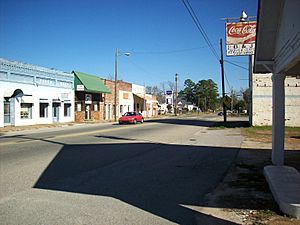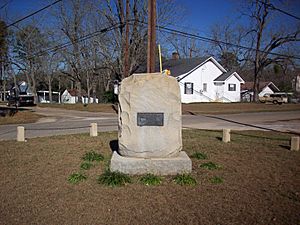Battle of Newton facts for kids
Quick facts for kids Battle of Newton, Alabama |
|||||||
|---|---|---|---|---|---|---|---|
| Part of American Civil War | |||||||
|
|||||||
| Belligerents | |||||||
| Commanders and leaders | |||||||
| 2LT Joseph G. Sanders 1st Florida Cavalry Regiment (Union) |
CPT Joseph Breare CS Home Guard |
||||||
| Strength | |||||||
| 44 | ~40 | ||||||
| Casualties and losses | |||||||
| 3 killed, 5 wounded | No casualties | ||||||
The Battle of Newton was a small fight that happened in the town of Newton, Alabama, on March 14, 1865. It took place during the last days of the American Civil War. Local soldiers from the Confederate Home Guard fought against a group of Union soldiers from the 1st Florida Cavalry. These Union soldiers had entered the Wiregrass area of Alabama without official permission.
The Union group was led by Second Lieutenant Joseph G. Sanders. He was a former captain in the Confederate Army who had changed sides. The Union soldiers wanted to burn the Dale Countycourthouse in Newton. However, local people saw them coming. The Home Guard ambushed the Union soldiers on the town square. The Union group was quickly defeated before they could cause any damage. Sanders reported three of his men were killed and five were wounded. The Home Guard had no casualties.
What Happened Before the Battle?

Dale County, where Newton is located, was a quiet area in Alabama before and during the Civil War. It had a small population and was mostly covered by pine forests. There were not many large farms or plantations. Because of this, it became a hiding place for soldiers who had left the Confederate Army without permission. These soldiers were called deserters. It was also a place for Southern people who supported the Union. These people were sometimes called "bushwhackers." They would often take supplies from local people.
One of these "bushwhacker" leaders was Joseph G. Sanders. He was from Dale County. He had first fought for the Confederacy. But in 1864, he decided to join the Union side. He became a second lieutenant in the 1st Regiment of Florida Cavalry (US). Sanders' group included Confederate deserters and local Union supporters.
In early 1865, a Union general named Alexander Asboth ordered Sanders to go into Washington County, Florida. His main job was to find new soldiers for the Union Army. He was also told to take horses and cattle from Confederate supporters.
But Sanders did not follow these orders. Instead, he and his men went to a swamp near Campbellton. They waited for a chance to attack Newton and burn the courthouse. This courthouse held records of Sanders' time in the Confederate Army. Another courthouse in a nearby county had already been burned by other "bushwhackers." Sanders hoped to do the same in Newton. Newton was also where the local Confederate office was located. This office was led by Captain Joseph Breare. He was a former officer who had been wounded in battle. He was now working to stop soldiers from avoiding the draft. This made Newton an even more attractive target for Sanders.
The Battle of Newton
Sanders and his men did not know that they had been seen on the roads leading to Newton. People in town guessed where they were going. Jesse Carmichael, a soldier who had lost a hand in a previous battle, was told about Sanders' approach. He quickly warned the town. As the citizens prepared to defend their village, Carmichael and another veteran rode out to watch for Sanders.
When Carmichael saw Sanders leading 44 mounted men, he quickly rode back to Newton. He led his neighbors to a good spot for an ambush near a spring. However, these men became worried about their families and returned to Newton.
Meanwhile, Captain Breare and his Home Guard unit had gathered in Newton. Breare immediately took charge of the town's defense. He wanted to keep the defenders close to the town square. This way, they could surprise Sanders among the buildings. He placed his men on the west side of the square.

Jesse Carmichael did not agree with Breare's plan. So, he took nine of his friends and placed them to the east of the square. Carmichael and three men hid near a hotel. The other six hid in a side street. Sanders and his group rode into Newton from the southeast at a fast speed. They were yelling and heading for the courthouse. Carmichael and his men let them pass. Then, they fired at them from behind with double-barrelled shotguns and rifles. At the same time, their friends fired into the front of Sanders' group.
The attackers were completely surprised. Their pistols and rifles did not work well. They quickly turned and rode out of town into the night. A one-handed former soldier and his nine friends had defeated a Union cavalry force four times their size. They did it on foot and in the dark. Not one of Carmichael's men was hurt. Breare's men on the other side of the square did not even get to fire a shot. Sanders reported that three of his soldiers were killed and five were wounded.
What Happened After the Battle?
Sanders' actions in Alabama were investigated in June 1865. He had been gone for four months instead of the fourteen days he was given for his mission. When he returned with only eight men out of twenty, the Army wanted to know why. Sanders claimed that bad weather, floods, and a lack of food for his horses forced him to hide in the swamp. He did not mention his failed attack on Newton. His superiors seemed satisfied, and he was not punished.
Sanders was allowed to leave the army in September 1865. He said he was worried about his family's safety. Sanders returned to Alabama. Some citizens of Newton tried to arrest him at his home. There was a struggle, and one person was killed. Sanders then fled to Decatur County, Georgia.
Even though this battle was small, it gave hope to the local people. They had suffered a lot from raiders like Sanders. The town later built a monument to honor the citizens who defended it that night. The monument can still be seen near the square. The county seat was moved to nearby Ozark in 1870.
In recent years, the Battle of Newton has become very important to the local community. There is an annual festival and reenactment held every October.

